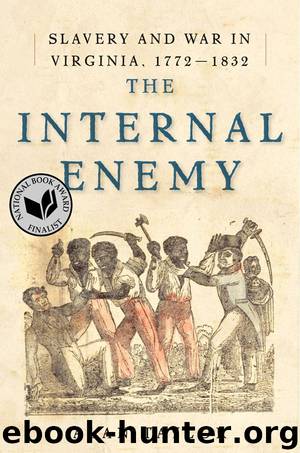The Internal Enemy: Slavery and War in Virginia, 1772-1832 by Taylor Alan

Author:Taylor, Alan [Taylor, Alan]
Language: eng
Format: epub
Publisher: W. W. Norton & Company
Published: 2013-09-09T04:00:00+00:00
News
On February 8, Cockburn received disturbing news: “an ugly account of peace being signed.” At Ghent on December 24, 1814, British diplomats had concluded a peace treaty with American negotiators. Worried about a renewed blowup in Europe, the imperial government sought to get out of the American war by offering generous terms. “It was fortunate for us that London is not as near to Washington as to Paris,” St. George Tucker noted. The peace treaty restored the prewar boundaries in North America: a great gain for the United States given that victorious British forces had occupied eastern Maine, northern Michigan, a corner of western New York, Tangier Island in the Chesapeake, and Cumberland Island on the coast of Georgia. Although British impressment of American sailors had been a major cause of the war, the treaty ignored that issue, which seemed moot to both sides after Napoléon’s defeat had reduced the Royal Navy’s demand for hands.39
Eager to press their military advantage over the Americans, British officers felt frustrated by the sudden peace on terms so favorable to their enemy. Cockburn complained, “This Peace . . . has knocked all my Schemes on the Head.” He insisted that a proper treaty would have made the enemy “pay dearer for their unjust and unprincipled Aggression.” Using a British nickname for Americans, Captain Barrie declared, “This Peace is a sad Damper to many of us who most sincerely wished to have fought [Jo]nathan into complete humiliation.” Barrie had sought “a disunion of the states, which would most certainly have taken place had the war been kept up for eight months longer.”40
While depressing to British officers, the news thrilled Americans, for it saved their nation from collapse. On February 13 in Baltimore, a man reported, “We have just received information of peace. Peace is in every one’s mouth, and, altho the streets are full of People whose mouths are wide open like snuff boxes, yet they cannot hold their peace, but run about grinning and chattering like so many monkies.” In Richmond, William H. Cabell assured his brother Joseph that the “glorious peace for America . . . has come exactly when we least expected but when we most wanted it. . . . You cannot form too extravagant an idea of the real joy which it has diffused through every circle here.”41
On February 15, 1815, the news came to Williamsburg, triggering a giddy celebration driven by a profound relief at escaping a national disaster. St. George Tucker reported, “It set us all in tip top spirits.” Just two months before, Tucker had noted the nation’s “horrid prospects” as he prepared to move his family and slaves into the interior, away from the danger of a British raid. He had then noted, “A happy new year to us all. We are all sadly in need of it.” That happiness came to Williamsburg in mid-February. Tucker “could hardly persuade myself [that] the news of peace was true, so unlooked for was it by us all.” Exulting
Download
This site does not store any files on its server. We only index and link to content provided by other sites. Please contact the content providers to delete copyright contents if any and email us, we'll remove relevant links or contents immediately.
| General | Discrimination & Racism |
Nudge - Improving Decisions about Health, Wealth, and Happiness by Thaler Sunstein(7238)
iGen by Jean M. Twenge(5158)
The Fire Next Time by James Baldwin(5015)
Adulting by Kelly Williams Brown(4230)
The Hacking of the American Mind by Robert H. Lustig(4080)
The Sports Rules Book by Human Kinetics(4072)
The Ethical Slut by Janet W. Hardy(4036)
Captivate by Vanessa Van Edwards(3721)
Mummy Knew by Lisa James(3519)
In a Sunburned Country by Bill Bryson(3361)
The Worm at the Core by Sheldon Solomon(3325)
Ants Among Elephants by Sujatha Gidla(3278)
Suicide: A Study in Sociology by Emile Durkheim(2902)
The Slow Fix: Solve Problems, Work Smarter, and Live Better In a World Addicted to Speed by Carl Honore(2837)
The 48 laws of power by Robert Greene & Joost Elffers(2800)
Humans of New York by Brandon Stanton(2683)
Handbook of Forensic Sociology and Psychology by Stephen J. Morewitz & Mark L. Goldstein(2603)
The Happy Hooker by Xaviera Hollander(2582)
The Tipping Point by Malcolm Gladwell(2553)
